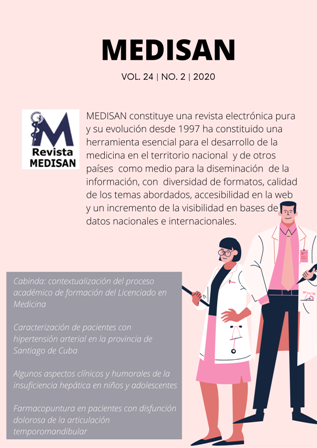Dylispidemia prevalence in obese patients
Keywords:
obesity, dyslipidemias, colesterol, high density lypoproteins, low density lypoproteins, lypoproteins.Abstract
Introduction: Dyslipidemias associated to obesity constitute risk factors of several diseases specially from the cardiovascular system.
Objective: To determine the prevalence of dyslipidemias in obese patients
Methods: A correlational restrospective and cross-sectional study of 150 obese patients, who visited the outpatients department of Medina Clinic from Hospital Básico in Guayaquil, from 2018 to 2019. Variables used were age, sex, body mass index and laboratory results such as total cholesterol, triglycerids. LDL colesterol and mixed dyslipidemias (cholesterol HDL and VLDL).
Results: In the serie, male sex (62.6 %), patients over 65 years (42.0 %), levels between critical and high risk (66 patients) prevailed, 16.0 % were classified as high risk patients with cholesterol level over 240 mg/dL. Sixty two patients showed subnormal results regarding triglycerids, in a rank higher than 150 with high limits and levels.
Conclusions: A correspondance between dyslipidemias and obesity was observed, as all patients presented some type of change in lipids.
Downloads
References
2. Candás Estébanez B, Pocoví Mieras M, Romero Román C, Vella Ramírez JC, Esteban Salán M, Castro Castro MJ, et al. Estrategia para el diagnóstico de las dislipidemias. Recomendación. 2018. Rev Lab Clin. 2019 [citado 13/12/2019]. Disponible en:
https://www.researchgate.net/publication/332772741_Estrategia_para_el_diagnostico_de_las_dislipidemias_Recomendacion_2018
3. Díaz Aragón A, Fernández Barros CL, Enciso Muñoz JM, Ceballos Reyes G, Gutiérrez Salmeán G, León Hernández FJ, et al. Posicionamiento en torno al diagnóstico y tratamiento de las dislipidemias. Rev Mex Cardiol. 2018 [citado 28/11/2019] 29 (Supl 3). Disponible en: https://www.medigraphic.com/pdfs/cardio/h-2018/hs183a.pdf
4. Ponte CI, IseaPerez JE, Lorenzatti AJ, Lopez Jaramillo P, Wyss FS, Pintó X, et al .Dislipidemiaaterogénica en Latinoamérica: prevalencia, causas y tratamiento. Rev. Venez. Endocrinol. Metab. 2017 [citado 28/11/2019]; 15 (2): 106-29. Disponible en: http://ve.scielo.org/scielo.php?script=sci_arttext&pid=S1690-31102017000200006&lng=es
5. Catapano AL, Graham I, De Backer G, Wiklund O, Chapman MJ, Drexel H, et al. Guía ESC/EAS 2016 sobre el tratamiento de las dislipemias. Rev Esp Cardiol. 2017 [citado 15/11/2019]; 70 (2): 115.e1-e64. Disponible en: https://www.revespcardiol.org/es-guia-esc-eas-2016-sobre-el-articulo-S0300893217300027
6. Villa Córdoba ML. Estudio descriptivo: Prevalencia de dislipidemia en adultos de 40 – 60 años, Cuenca -Ecuador, enero a julio 2014. Rev Med HJCA. 2018[citado 15/11/2019]; 10 (3): 204 – 8. Disponible en: http://docs.bvsalud.org/biblioref/2019/06/999307/estudio-descriptivo-prevalencia-de-dislipidemia-en-adultos-de-4_zCrAn1d.pdf
7. Miguel Soca PE. Dislipidemias. ACIMED. 2009 [citado 18/11/2019]; 20 (6): 265-73. Disponible en: http://scielo.sld.cu/scielo.php?script=sci_arttext&pid=S1024-94352009001200012&lng=es
8. Bevaqua A. Dislipidemia, obesidad e hipovitaminosis D en el adulto mayor: ¿tratamiento único? Revista de la Asociación Médica de Bahía Blanca. 2016 [citado 15/11/2019]; 26 (1).
http://docs.bvsalud.org/biblioref/2018/03/880457/rcambb_vol26_n1_2016_20_29.pdf
9. Sapunar J, Aguilar Farías N, Navarro J, Araneda G, Chandía Poblete D, Manríquez V, et al. Alta prevalencia de dislipidemias y riesgo aterogénico en una población infanto-juvenil. RevMed Chile. 2018 [citado 15/11/2019]; 146: 1112-22. Disponible en:
https://scielo.conicyt.cl/pdf/rmc/v146n10/0034-9887-rmc-146-10-01112.pdf
10. Castillo Castillo JL, Oscanoa Espinoza TJ. Dislipidemia como factor de riesgo para enfermedad cerebrovascular: estudio de casos y controles. Horiz. Med. 2016 [citado 15/11/2019]; 16 (4): 13-9. Disponible en: http://www.scielo.org.pe/scielo.php?script=sci_arttext&pid=S1727-558X2016000400003&lng=es
11. Escobedo de la Peña J, Pérez RJ, Schargrodsky H, Champagne B. Prevalencia de dislipidemias en la ciudad de México y su asociación con otros factores de riesgo cardiovascular. Resultados del estudio CARMELA. Gac Méd Méx. 2014 [citado 15/11/2019]; 150: 128-36. Disponible en: https://www.anmm.org.mx/GMM/2014/n2/GMM_150_2014_2_128-136.pdf
Published
How to Cite
Issue
Section
License
All the articles can be downloaded or read for free. The journal does not charge any amount of money to the authors for the reception, edition or the publication of the articles, making the whole process completely free. Medisan has no embargo period and it is published under the license of Creative Commons, International Non Commercial Recognition 4.0, which authorizes the copy, reproduction and the total or partial distribution of the articles in any format or platform, with the conditions of citing the source of information and not to be used for profitable purposes.





